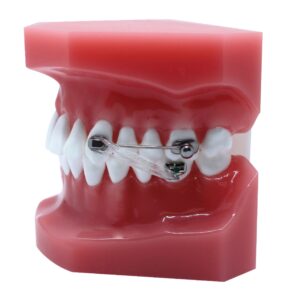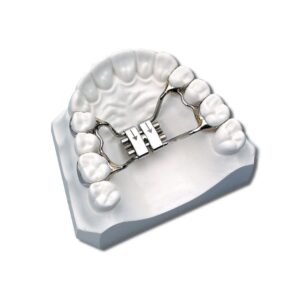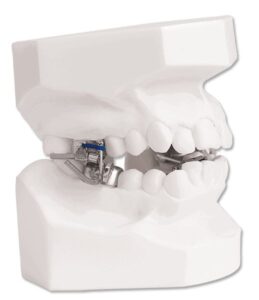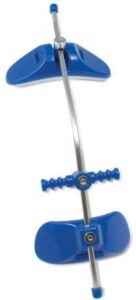Phase 1 Treatment
At Leland Orthodontics, we believe in providing comprehensive orthodontic care that caters to the unique needs of our patients. One of the ways we do this is through Phase 1 Treatment, a proactive approach targeting children between the ages of 6 and 10. This early intervention can help correct growth issues, prevent more severe problems down the line, and create a healthier environment for your child’s future permanent teeth.
Phase 1 Treatment, also known as Early Intervention or Interceptive Treatment, is a focused orthodontic approach designed to address specific issues that may be present in a child’s growing mouth, jaws, and airway. It’s not about straightening the teeth but rather guiding the growth and development of the jaws to accommodate incoming permanent teeth and establishing an ideal airway.
Some common issues that Phase 1 Treatment may address include crossbites, overcrowding, and issues with jaw growth and/or a small airway. By intervening early, we can potentially reduce the need for more extensive treatment or surgery later on.
The Process of Phase 1 Treatment
The process begins with an evaluation by Dr. Leland to determine whether your child could benefit from Phase 1 Treatment. If recommended, a personalized treatment plan will be crafted. This could involve the use of partial braces, expanders, or other orthodontic appliances to guide the growth of the jaws and teeth.
After Phase 1 Treatment is completed, there’s usually a resting period where no active orthodontic treatment takes place. During this time, the remaining permanent teeth are allowed to erupt naturally. Once all the permanent teeth have come in, we’ll assess the need for further treatment—referred to as Phase 2 Treatment.
Starting Early for a Healthier Smile
At Leland Orthodontics, we’re committed to setting your child up for a lifetime of beautiful smiles and dental and airway health. Phase 1 Treatment is a proactive step towards achieving this goal. By addressing potential issues early, we can help guide your child’s oral development and lay the foundation for a healthy, well-aligned smile and an optimized airway.
If you think your child may benefit from Phase 1 Treatment, or if you have questions about our approach to early orthodontic care, we invite you to contact us today to request a consultation. Let’s work together to give your child the best start on their journey towards a beautiful, confident smile.

Airway Orthodontics
Nothing is more central to healthy human life than the act of breathing. That’s why airway-conscious treatment is so important. At Leland Orthodontics, we consider the health of your airway when planning your treatment to give you the best results.
You may wonder why doctors assess your quality of sleep while discussing breathing. This is because your airways are in their most vulnerable positions when you sleep.
As you sleep, you lose muscle tone throughout your body, so when you’re lying down, your airway is more likely to close due to gravity. This can interrupt your sleep, causing you to wake up when you should be able to recharge. Simply put, your muscles are at their weakest when you sleep, so if you have healthy breathing patterns while sleeping, you most likely breathe well when you’re awake.
The Proper Way to Breathe
While you can certainly breathe through your mouth and nose, the best way to breathe is nasal. Nasal breathing offers numerous health benefits, including:
- Breathing with your mouth closed allows the proper resting posture of the tongue braced against the roof of the mouth, which encourages proper jaw development.
- This type of breathing also allows for better air filtration and humidification.
- Increased resistance promotes deeper breathing, increasing oxygen intake and distribution.
- Nitric oxide mixes with the air, which improves the lungs’ ability to absorb oxygen.
The Problem with Snoring
Contrary to popular belief, snoring isn’t normal and indicates a compromised airway. The sounds of snoring are the result of the airway collapsing during sleep.
Snoring indicates that the brain isn’t getting the oxygen it needs to become fully rested. Because of these reasons, improper breathing is a serious health condition that requires treatment.
Side Effects of Mouth Breathing
We learned about the health benefits of nasal breathing in the last section, so let’s see the effects of mouth breathing:
- Mouth breathing means breathing unfiltered air.
- Nitric oxide is not added to inspired air, which decreases the lungs’ ability to absorb oxygen.
- Shallow breathing reduces the amount of oxygen transferred into the body.
- Tongue position during sleep can lead to underdeveloped jaw bones.
These are the most direct adverse effects of mouth breathing. Unfortunately, there are also indirect adverse effects of chronic mouth breathing, which stem from getting inadequate oxygen to the brain. These adverse effects include:
- A constant lethargic feeling
- ADD or ADHD
- Bedwetting
- Difficulty focusing on tasks
- Getting labeled as a “problem child”
- Irritability
- Non-restful sleep
- Poor performance at school or work
- Increased risk for cavities and periodontal disease
Timing Is Everything
Orthodontists like Dr. Leland do more than straighten teeth — they spend a great deal of time focusing on the growth and development of the jaws and how to make sure everything progresses properly. Timing is everything when it comes to orthodontic treatment to change the relationship of the jaw bones.
We identify the Golden Period of a child’s orthodontic development between the ages of 7 and 9. During this time, we can modify the jaws to create space for erupting teeth, create ideal alignment, and form an ideal airway. Making changes at this early stage will benefit a child’s smile for their entire life, without invasive treatment.
Two-Phase Treatment
Phase 1
Phase 1 occurs between the ages of 7 and 9 when there are enough permanent teeth for treatment to be effective, but there are still primary (baby) teeth in the mouth.
The main objective of Phase 1 treatment is to properly align the jaws and put the airway in the best possible position. Although we always strive to achieve an esthetic outcome, the main goal of Phase 1 is NOT cosmetic, and we often use appliances like expanders and facemasks.
Phase 2
Phase 2 can occur as early as 11 years old and includes all patients older than this. By the end of Phase 2, all permanent teeth have erupted and are properly aligned. The goals of Phase 2 are to get the best results regarding your smile esthetics, tooth alignment, bite, and airway.
Orthodontic Treatment for Airways
Let’s explore several treatments we use in our office to correct an improper jaw-bone relationship.
Rapid Palatal Expander
To expand a palate, we attach a rapid palatal expander (RPE) to the upper molars, one on the right and one on the left. To activate the expander, you’ll turn a screw joint to widen the expander. After the final turn of the expander screw, we’ll leave the appliance in place for four to six months to ensure the bone has fully backfilled in the space created.
Timing For Maxillary Expansion: On average, we can expand the maxilla (the upper jaw bone) any time before age 12. At 12 years old, the mid-palatal suture “fuses,” which means that the gap turns into solid bone. After this happens, expansion doesn’t work because there is no “weak point” we can use to expand the maxilla.
Facemask
A facemask is an appliance that is worn outside the mouth, on the face, also known as an “extra-oral appliance.” It attaches to a metal orthodontic appliance fixed inside the mouth to one molar on each side of the upper jaw, similar to an expander.
Timing: TIMING IS EVERYTHING, especially with facemasks! It is extremely important that children visit an orthodontist soon after their 7th birthday. Many kids do not need treatment at this age, but for those who do, it is critical to be completed before their jaws finish growing!
MARA Appliance
The MARA appliance is an intra-oral appliance with two pieces; one attaches to the upper jaw, and one attaches to the lower jaw. The purpose of this appliance is to move a mandible (lower jaw) forward, in cases where it is too small, or set too far back. When the patient bites down, the MARA appliance shifts the mandible forward and holds it there for six to nine months, allowing it to grow into the proper position.
Timing: The forward growth of the mandible is the last dimension of jaw growth to finish. The most effective time to use a MARA is at the beginning of Phase 2, approximately 11½ years old.

Common Orthodontic Appliances
At Leland Orthodontics, we utilize advanced orthodontic appliances to provide personalized treatment plans that effectively correct a variety of dental issues. Here’s an overview of some of the common orthodontic appliances we use.

D2
The D2 is a bite correction appliance that Dr. Leland uses before braces that focuses on correcting how the back teeth bite together. This is often the most time-consuming stage of treatment when done with braces alone. With D2, bite correction is faster and more comfortable, ultimately decreasing your treatment time.
Each D2 arm (right and left) has pads glued onto the upper canine tooth and the corresponding upper first molar tooth. Two buttons (one on each side) are glued onto the bottom first molar teeth. Elastics (orthodontic rubber bands) are worn from the D2’s arm on the upper canine to the button on the lower first molar for about 4-6 months to correct your bite.
You must wear a lower clear retainer whenever you wear elastics (rubber bands) with the D2 appliance. After the bite is corrected, the D2 appliance is removed, and braces are placed on all teeth to continue treatment.

Expanders
A palatal or maxillary expander is a device designed to widen the upper jaw. It’s often used to correct crossbites and make room for crowded teeth. The expander is attached to the upper molars through cemented bands and gradually widens the palate by applying gentle pressure over time. This process creates more space in a child’s mouth, allowing for better tooth alignment and a healthier smile.

MARA
The MARA (Mandibular Anterior Repositioning Appliance) is used to correct overbites by repositioning the lower jaw forward. It consists of two crowns placed on the first molars and an elbow-like component that interacts between the upper and lower parts of the device. This design encourages the forward growth of the lower jaw. MARA is generally used in growing children and adolescents, where it can take advantage of their growth spurts for optimal results.

Facemask
A facemask, also known as a reverse-pull headgear, is an external appliance used to treat underbite in children whose jaws are still growing. The appliance pulls the upper jaw forward and downward to align with the lower jaw. It consists of a forehead pad, chin cup, and facebow that connects to the braces or expanders inside the mouth. Leland Orthodontics patients are instructed to ONLY wear their facemask at home. The ideal wear time is 12 hours a day.

Zoom! Whitening
You only get one smile, and we believe you should love yours. A beautiful, bright smile can boost your confidence, and that’s what you deserve.
At Leland Orthodontics, we not only straighten your teeth — but we can also brighten your smile with our Zoom whitening treatment. Exclusively for our patients, this 2-hour, in-office appointment includes a take-home maintenance kit and a smile up to 8 shades whiter for only $499.
How it Works
First, we’ll cover your lips and gums, exposing your teeth. Next, we’ll apply the Zoom whitening gel to your teeth. The Zoom light activates the gel to penetrate your teeth and break up stains and discoloration. We’ll leave the gel on your teeth for 15 minutes while the light is activated. This process is entirely pain-free, so you can sit back and relax.
The entire treatment includes up to four 15-minute sessions of light activation for a total of 60 minutes. After your treatment, we will apply a sensitivity-reducing fluoride paste gel to your teeth. For patients we have treated previously, we provide a take-home kit for maintenance in your retainer.
Zoom teeth whitening is a great way to get a brighter smile, with lasting results ranging from six to eight shades whiter than when you started!
Differences Between In-Office & At-Home Teeth Whitening
The main difference between at-home and in-office teeth whitening treatment is peroxide levels. Whitening methods used by a trained professional will have slightly higher peroxide levels than those used at home.
At Leland Orthodontics, we offer safe, effective options for teeth whitening that fit your lifestyle. Remember, it’s always more reliable to trust your dental care to a professional than kits you can order online!
How Much Does Teeth Whitening Cost?
The cost of teeth whitening is $499, but, as with any procedure, may vary. It depends on which treatment option you choose for whitening, how much treatment you need, and how many appointments are necessary to see the desired results.
Here at Leland Orthodontics, we offer a variety of payment plans to ensure treatment is always affordable and fits your lifestyle. We also allow for our patients to add the whitening treatment to their orthodontic payment plan.
Contact our Reno office today if you’re ready to learn more about teeth whitening with Leland Orthodontics. Our team is always here to help answer any questions and schedule you for your first appointment!